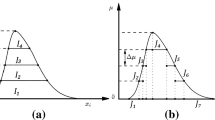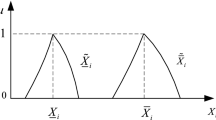Abstract
Fuzzy uncertainty (FU) exists widely in engineering applications, but there lack design optimization methods under FU, thus a credibility-based design optimization (CBDO) is focused to obtain the safety design under FU in this paper. Firstly, the concepts of credibility index and most credible point (MCP) are presented to measure the safety degree under FU, where the credibility index and the MCP, respectively, show similar properties as the reliability index and the most probable point under random uncertainty. Secondly, the inverse MCP (IMCP) is defined with respect to the required credibility, and the detailed method is established for searching IMCP, on which the performance measure approach (PMA) can be combined to solve the CBDO. Since the PMA combined with the IMCP includes a time-consuming double-loop strategy, the sequential optimization and credibility assessment (SOCA) is proposed to decouple the double-loop strategy thirdly. In the SOCA, a shifting vector constructed by the IMCP is used to transform the credibility constraint into an equivalent deterministic one, on which the double-loop strategy can be avoided to reduce the computational cost for solving the CBDO. One numerical example and two engineering examples fully illustrate the efficiency and accuracy of the SOCA.







Similar content being viewed by others
References
Yao, W., Chen, X., Luo, W., et al.: Review of uncertainty-based multidisciplinary design optimization methods for aerospace vehicles. Prog. Aerosp. Sci. 47, 450–479 (2011)
Aoues, Y., Chateauneuf, A.: Benchmark study of numerical methods for reliability-based design optimization. Struct. Multidiscipl. Optim. 41, 277–294 (2010)
Reddy, M., Grandhi, R.: Reliability based structural optimization: a simplified safety index approach. Comput. Struct. 53(6), 1407–1418 (1994)
Tu, J., Choi, K., Park, Y.: A new study on reliability-based design optimization. J. Mech. Des. 121(4), 557–564 (1999)
Lee, J., Yang, Y., Ruy, W.: A comparative study on reliability-index and target-performance-based probabilistic structural design optimization. Comput. Struct. 80(3), 257–269 (2002)
Liang, J., Mourelatos, Z., Tu, J.: A single-loop method for reliability-based design optimization. In: Proceedings of ASME design engineering technical conferences (2004)
Jiang, C., Qiu, H., Gao, L., et al.: An adaptive hybrid single-loop method for reliability-based design optimization using iterative control strategy. Struct. Multidiscipl. Optim. 56(6), 1271–1286 (2017)
Keshtegar, B., Hao, P.: Enhanced single-loop method for efficient reliability-based design optimization with complex constraints. Struct. Multidiscipl. Optim. 57, 1731–1747 (2018)
Du, X., Chen, W.: Sequential optimization and reliability assessment method for efficient probabilistic design. J. Mech. Des. 126(2), 225–233 (2004)
Cheng, G., Xu, L., Jiang, L.: A sequential approximate programming strategy for reliability-based structural optimization. Comput. Struct. 84(21), 1353–1367 (2006)
Cho, T., Lee, B.: Reliability-based design optimization using convex linearization and sequential optimization and reliability assessment method. Struct. Saf. 33(1), 42–50 (2011)
Chen, Z., Qiu, H., Gao, L., et al.: An adaptive decoupling approach for reliability-based design optimization. Comput. Struct. 117, 58–66 (2013)
Yi, P., Zhu, Z., Gong, J.: An approximate sequential optimization and reliability assessment method for reliability-based design optimization. Struct. Multidiscipl. Optim. 54(6), 1367–1378 (2016)
Yin, H., Yu, D., Yin, S., et al.: Possibility-based robust design optimization for the structural-acoustic system with fuzzy parameters. Mech. Syst. Sign. Process. 102, 329–345 (2018)
Beer, M., Liebscher, M.: Designing robust structures—a nonlinear simulation based approach. Comput. Struct. 86, 1102–1122 (2008)
Wu, Y.Q., Lu, R.Q., Shi, P., et al.: Sampled-data synchronization of complex networks with partial couplings and T–S fuzzy nodes. IEEE Trans. Fuzzy Syst. 26(2), 782–793 (2017)
Wu, Y.Q., Karimi, H.R., Lu, R.Q.: Sampled-data control of network systems in industrial manufacture. IEEE Trans. Industr. Electron. 65(11), 9016–9024 (2018)
Zadeh, L.A.: Fuzzy sets as a basis for a theory of possibility. Fuzzy Sets Syst. 1(1), 3–28 (1978)
Dubois, D., Prade, H.: Possibility theory: an approach to computerized processing of uncertainty. Plenum Press, New York (1988)
Mourelatos, Z.P., Zhou, J.: Reliability estimation and design with insufficient data based on possibility theory. AIAA journal 43(8), 1696–1705 (2005)
Du, L., Choi, K.K., Youn, B.D.: Inverse Possibility Analysis Method for Possibility-Based Design Optimization. AIAA Journal 44(11), 2682–2690 (2006)
Tang, Z.C., Lu, Z.Z., Hu, J.X.: An efficient approach for design optimization of structures involving fuzzy variables. Fuzzy Sets Syst. 225, 52–73 (2014)
Wang, C., Qiu, Z., Xu, M., et al.: Novel numerical methods for reliability analysis and optimization in engineering fuzzy heat conduction problem. Struct. Multidiscipl. Optim. 56(6), 1247–1257 (2017)
Youn, B.D., Choi, K.K., Du, L., et al.: Integration of possibility-based optimization and robust design for epistemic uncertainty. J. Mech. Des. 129(8), 876–882 (2007)
Liu, B.: Uncertainty theory, 2nd edn. Springer, Berlin (2002)
Jia, B.X., Lu, Z.Z.: Root finding method of failure credibility for fuzzy safety analysis. Struct. Multidiscipl. Optim. 58, 1917–1934 (2018)
Feng, K.X., Lu, Z.Z., Pang, C., et al.: Time-dependent failure credibility analysis and its optimization based computational methods. Eng. Struct. 181, 605–616 (2019)
Möller, B., Graf, W., Beer, M.: Fuzzy structural analysis using α-level optimization. Comput. Mech. 26, 547–565 (2000)
Ling, C.Y., Lu, Z.Z., Feng, K.X.: An efficient method combining adaptive Kriging and fuzzy simulation for estimating failure credibility. Aerosp. Sci. Technol. 92, 620–634 (2019)
Wang, J.Q., Lu, Z.Z., Shi, Y.: Aircraft icing safety analysis method in presence of fuzzy inputs and fuzzy state. Aerosp. Sci. Technol. 82–83, 172–184 (2018)
Liu, B., Liu, Y.K.: Expected value of fuzzy variable and fuzzy expected value models. IEEE Trans. Fuzzy Syst. 10, 445–450 (2002)
Marano, G.C., Quaranta, G.: A new possibilistic reliability index definition. Acta Mater. 210, 291–303 (2010)
Jia, B. X., Lu, Z. Z:. A structural safety analysis method in the presence of fuzzy uncertainty, Fuzzy sets and systems, under review (2019)
Du, X., Sudjianto, A., Chen, W.: An integrated framework for optimization under uncertainty using inverse reliability strategy. J. Mech. Des. 126, 562–570 (2004)
Min, J. H., Choi, D. H.: Reliability analysis technique using local approximation of a cumulative distribution function. In: 6th World Congresses of structural and multidisciplinary optimization, Rio de Janeiro, Brazil, (2005)
Wu, Y.T.: Computational methods for efficient structural reliability and reliability sensitivity analysis. AIAA J. 32(8), 1717–1723 (1994)
Youn, B.D., Choi, K.K., Park, Y.H.: Hybrid analysis method for reliability-based design optimization. J. Mech. Des. 125(2), 221–232 (2003)
Youn, B.D., Choi, K.K., Du, L.: Adaptive probability analysis using an enhanced hybrid mean value method. Struct. Multidiscipl. Optim. 29(2), 134–148 (2004)
Liu, B.: UncertaintyTheory, 4th edn. Springer, Berlin (2015)
Lee, J.J., Lee, B.C.: Efficient evaluation of probabilistic constraints using an envelope function. Eng. Optim. 37(2), 185–200 (2005)
Youn, B.D., Choi, K.K.: Reliability-based design optimization for crashworthiness of vehicle side impact. Struc. Multidiscipl. Optim. 26, 272–283 (2004)
Acknowledgements
The support by the National Natural Science Foundation of China (Grant 51775439) and National Science and Technology Major Project (2017-IV-0009-0046) are gratefully acknowledged.
Author information
Authors and Affiliations
Corresponding author
Appendices
Appendices
1.1 Appendix 1
1.2 Appendix 2
1.2.1 A Brief Introduction to Fuzzy Advanced First-Order Second-Moment (FAFOSM) Method
Consider a non-linear performance function \( Y = g\left( {\mathbf{X}} \right) \), and the MCP \( P^{*} \left( {x_{1}^{*} ,x_{2}^{*} , \cdots ,x_{n}^{*} } \right) \) is confined in the limit state equation as \( g(P^{*} ) = 0 \). \( \tilde{Y} \) is expanded as the first-order Taylor series at \( P^{*} \):
Thus, the linearized limit state equation is \( \mathop \sum \nolimits_{i = 1}^{n} \left( {{{\partial g} \mathord{\left/ {\vphantom {{\partial g} {\partial x_{i} }}} \right. \kern-0pt} {\partial x_{i} }}} \right)_{{P^{ *} }} \left( {x_{i} - x_{i}^{ *} } \right) = 0 \). According to the linear addition law of fuzzy expectation and variance [39], the approximate fuzzy first- and second-order moments are \( \tilde{E}\left( {\tilde{Y}_{{P^{ *} }} } \right) = \mathop \sum \nolimits_{i = 1}^{n} \left( {{{\partial g} \mathord{\left/ {\vphantom {{\partial g} {\partial x_{i} }}} \right. \kern-0pt} {\partial x_{i} }}} \right)_{{P^{ *} }} \left( {\mu_{i} - x_{i}^{ *} } \right) \) and \( \sqrt {\tilde{D}\tilde{Y}_{{P^{ *} }} } = \mathop \sum \nolimits_{i = 1}^{n} \left| {\left( {{{\partial g} \mathord{\left/ {\vphantom {{\partial g} {\partial x_{i} }}} \right. \kern-0pt} {\partial x_{i} }}} \right)_{{P^{ *} }} } \right|\sigma_{i} \). Then the credibility index can be expressed as
After transforming all input variables and limit state equation into standardized space, the linearized limit state equation becomes \( \mathop \sum \nolimits_{i = 1}^{n} \left( {{{\partial g} \mathord{\left/ {\vphantom {{\partial g} {\partial x_{i} }}} \right. \kern-0pt} {\partial x_{i} }}} \right)_{{P^{*} }} \sigma_{i} (u_{i} - u_{i}^{*} ) = 0 \). Since the contour topology of the JMF of U is a series of hypercubes centered at the origin, coordinates of the MCP are solved by the following equations:
In most cases, the MCP is on the vertex of the joint membership contour, i.e., \( \left| {u_{1} } \right| = \left| {u_{2} } \right| = \cdots = \left| {u_{n} } \right| = t \). After basic mathematical operations, it is not hard to obtain \( t = \frac{{\mathop \sum \nolimits_{i = 1}^{n} \left( {{{\partial g} \mathord{\left/ {\vphantom {{\partial g} {\partial x_{i} }}} \right. \kern-0pt} {\partial x_{i} }}} \right)_{{P^{ *} }} \left( {\mu_{i} - x_{i}^{ *} } \right)}}{{\mathop \sum \nolimits_{i = 1}^{n} \left| {\left( {{{\partial g} \mathord{\left/ {\vphantom {{\partial g} {\partial x_{i} }}} \right. \kern-0pt} {\partial x_{i} }}} \right)_{{P^{ *} }} } \right|\sigma_{i} }} \), which is also the definition of \( \tilde{\beta } \) exactly as shown in Eq. (B.2). As a result, compared with AFOSM in reliability, the MCP (or design point) can be considered as the point located at the limit state equation has the shortest Chebyshev distance to the origin.
Rights and permissions
About this article
Cite this article
Wang, L., Lu, Z. & Jia, B. A Decoupled Method for Credibility-Based Design Optimization with Fuzzy Variables. Int. J. Fuzzy Syst. 22, 844–858 (2020). https://doi.org/10.1007/s40815-020-00813-0
Received:
Revised:
Accepted:
Published:
Issue Date:
DOI: https://doi.org/10.1007/s40815-020-00813-0




